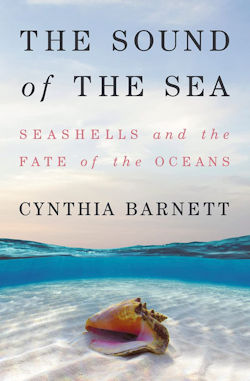SEJournal Online is the digital news magazine of the Society of Environmental Journalists. Learn more about SEJournal Online, including submission, subscription and advertising information.
BookShelf: The Call of the Conch — How Seashells Tell Nature’s Story
“The Sound of the Sea: Seashells and the Fate of the Oceans”
By Cynthia Barnett
W.W. Norton & Co., $27.95
Reviewed by Tom Henry
 |
“A book for the ages.” That’s what Jack E. Davis, Pulitzer Prize-winning author of “The Gulf: The Making of an American Sea,” calls fellow Floridian Cynthia Barnett’s latest work, “The Sound of the Sea: Seashells and the Fate of the Oceans.”
Historian Douglas Brinkley labels it “an instant classic of nature history” that, in the tradition of Rachel Carson, “enchantingly weaves poetic musings with deep-seated conservation wisdom and ocean science.”
Lofty praise, indeed. But it’s spot on. Barnett’s incredible fourth book is a doozy.
Her writing and research have always been good, and she’s taken both up a notch, in a book which unfolds as a love affair with nature through the lens of mollusks and their seashells.
Obsession with shells
There are few books I’ve read in recent years from which I’ve learned more.
First, there’s the amazing science behind shells and how mollusks create them. I never really considered that, let alone considered there’s a whole realm of science known as conchology.
Nor did I consider the religious and economic power of shells over time, or that shells known as Lightning Whelk have been coveted because their spirals are one of the few that are formed counter-clockwise.
There is one marvelous anecdote after another, such as how archeologists have unearthed scores of seashells at Pompeii, the ancient Italian city buried in volcanic ash when Mount Vesuvius erupted.
And the obsession with shells experienced by high-profile figures such as Rembrandt, Japan’s Emperor Hirohito and Cuba’s Fidel Castro. Castro was so fascinated with queen conchs, she points out, that the CIA had considered using them as booby traps in a 1963 assassination plot that was never carried out, according to declassified documents made public in 2017.
Readers also learn how Charles Lindbergh’s wife, aviator Anne Morrow Lindbergh, was arguably an early feminist who wrote her bestselling book, “Gift From the Sea,” to explain how seashells became a calming influence on her.
Travels through time and around the world
There are many trips back in time, such as Barnett’s interest with an ancient tribe of Native Americans in southwest Florida known as the Calusa, which died out in the late 1700s.
She offers great insight into the religious and cultural significance of shell mounds and how they have been impacted by road construction.
There are even a few paragraphs devoted to the sexual allure of shells.
Barnett notes that in “The Story of V,” Catherine Blackledge’s biography of the vagina, many mollusks “have contoured, involute apertures that ‘bear a marked resemblance to the folds and curves of external female genitalia.’” In some provinces of Japan, she writes, the word for vagina is “kai,” which means shell.
Her writing, as good as it is, is equaled or
surpassed by her incredible research. This
book is a marvel in the art of reporting itself.
Barnett goes on worldwide journeys for her research, to the Maldives and other faraway places, and sometimes with her son Will by her side. She writes about growing pollution problems, from the impact of plastics to climate change, and probes issues such as environmental ethics.
The latter includes the past practice of harvesting live seashells, especially on Florida’s Sanibel Island.
A standing joke among Floridians was how the best seashells were likely at the Georgia State Line, which is about as far as tourists heading back north could get before they were so overwhelmed by the stench of dying mollusks that they likely gave up and dumped their haul along the highway.
Barnett explains how the initial response by Sanibel motel operators was to pay for so-called “boiling stations” for people to kill their mollusks down by the beach instead of stinking up their rooms with them. Today, of course, such harvests are forbidden.
Deep research, sound science
While “The Sound of the Sea: Seashells and the Fate of the Oceans” is a great read, that doesn’t mean it’s light on science.
Barnett weaves countless scientific terms and concepts into her engaging prose. This book isn’t for the faint of heart, young readers, or those looking for a simple overview of seashell history.
Her writing, as good as it is, is equaled or surpassed by her incredible research. This book is a marvel in the art of reporting itself, and not just because of its panoramic, global perspective.
It takes a deep dive into history and will likely leave many readers scratching their heads, wondering why they’d never seen how seashells have factored into our lives, culture, customs and beliefs so greatly.
This book is a great reminder for environmental journalists how everything around us in nature has a story to it, with links to the past that can reveal something about human behavior.
That’s true even if they are one of the world’s most coveted conchs or just one of the millions of tiny seashells that people largely overlook by their feet as they walk the beach.
Tom Henry is SEJournal’s BookShelf editor, a member of SEJournal’s editorial board, a former Society of Environmental Journalists board member and a longtime journalist who created The (Toledo) Blade’s environment beat in 1993. He is a longtime SEJ friend of Barnett’s and has followed her successful transition to a book-writing career from the start.
* From the weekly news magazine SEJournal Online, Vol. 7, No. 5. Content from each new issue of SEJournal Online is available to the public via the SEJournal Online main page. Subscribe to the e-newsletter here. And see past issues of the SEJournal archived here.













 Advertisement
Advertisement 



